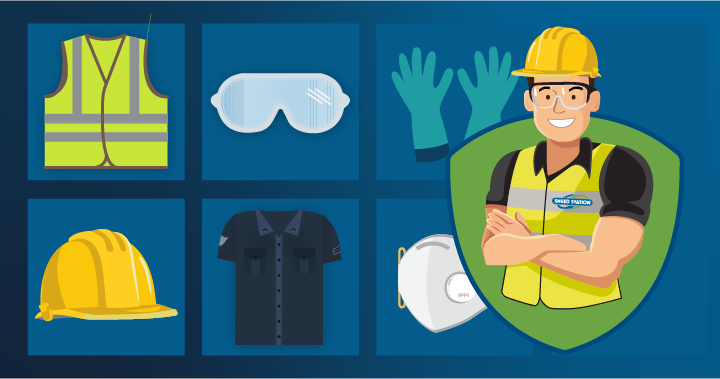Everything you need to know about destroying PPE and safety equipment
When it comes to the secure disposal of PPE, there are a lot of things to consider. What is the PPE made from? Is it recyclable? Is it reusable? Do materials need to be separated by type? Would there be any risks to the public if the PPE wasn’t disposed of correctly? We’re here to answer these questions and assist with any PPE disposal and destruction requirements you may have.
There are many reasons you may need to dispose of PPE. Perhaps you ordered too much, and the surplus is no longer needed. Maybe it has been contaminated and is no longer suitable for use. Or, perhaps you have found that the PPE you once purchased is no longer suitable for what you need it for.
Whatever the reason is for you to destroy PPE and safety equipment, always ensure your PPE is disposed of properly by a fully accredited company with a valid waste carriers license. This will prevent the risks of environmental crimes like PPE flytipping.
What are the different forms of PPE?
PPE comes in many forms. This includes, but is not limited to:
- Eye protection – Such as goggles, safety glasses, and welding masks.
- Ear protection – Ear defenders, earbuds and earmuffs.
- Head protection – Hard hats, safety helmets.
- Protection from fire – Fire-resistant clothing, bunker gear, turnout gear.
- Respiratory protection – Dust masks, face shields, face coverings, gas masks, and respirators.
- Protective handwear – Safety gloves, needle-resistant gloves, and disposable gloves.
- Safety footwear – Steel toe cap boots, safety shoes and things like gumboots.
- Safety clothing – Hazmat suits, coveralls, aprons, hi-vis clothing, chaps, and neck shields.
- Safety accessories – Harnesses, inflatable life jackets, mouth guards and things like hair nets.
- Body armour – Stab vests, riot shields, or even chainmail.
For public safety, you should securely destroy PPE when you no longer need it. Doing this can help to prevent accidents such as your employees using faulty or broken PPE items. It can also reduce the risk of the public accessing things that could be contaminated or dangerous. So, how can you best ensure the secure disposal or destruction of your PPE?

How to manage PPE waste.
When you need to securely dispose of PPE, the most important thing to do is to separate hazardous waste from non-hazardous waste. For instance, if you needed to destroy 100 clean stab vests and 5 stab vests contaminated with bodily fluids, you would need to keep those 5 contaminated vests separately from the clean vests. You can easily shred, securely recycle or incinerate the clean vests. However, you must double-bag the contaminated vests and destroy them as hazardous waste. This goes for any type of contaminated PPE.
With any form of recyclable PPE, it’s also helpful to separate these items into types. For example, plastic goggles may be easy to shred and recycle on their own but are quite difficult to separate and recycle when mixed with ten other types of non-plastic PPE. Separating your materials pre-shredding will help to maximise the recycling rates of your protective equipment after shredding. If you aren’t able to separate by fibre, mixed-fibre items like safety gloves may still be recyclable after destruction. Rag recycling is a process where mixed shredded fibres can be used to create items like carpet underlay, mattress stuffing and insulation. Whether this is possible depends on the materials you have for shredding. If you aren’t sure, let us know and we can assist.
At Shred Station, we specialise in the secure disposal of endless types of materials. We perform award-winning shredding services for police forces, fire departments, workshops, hospitals, and countless other businesses across the UK that require regular PPE destruction. We also have a wide network of waste-management partners for facilitating collections of hazardous waste. So, whatever PPE you need to destroy or dispose of, our team of shredding experts can help.
Sign up for our newsletter to receive alerts about information protection and Shred Station news.
